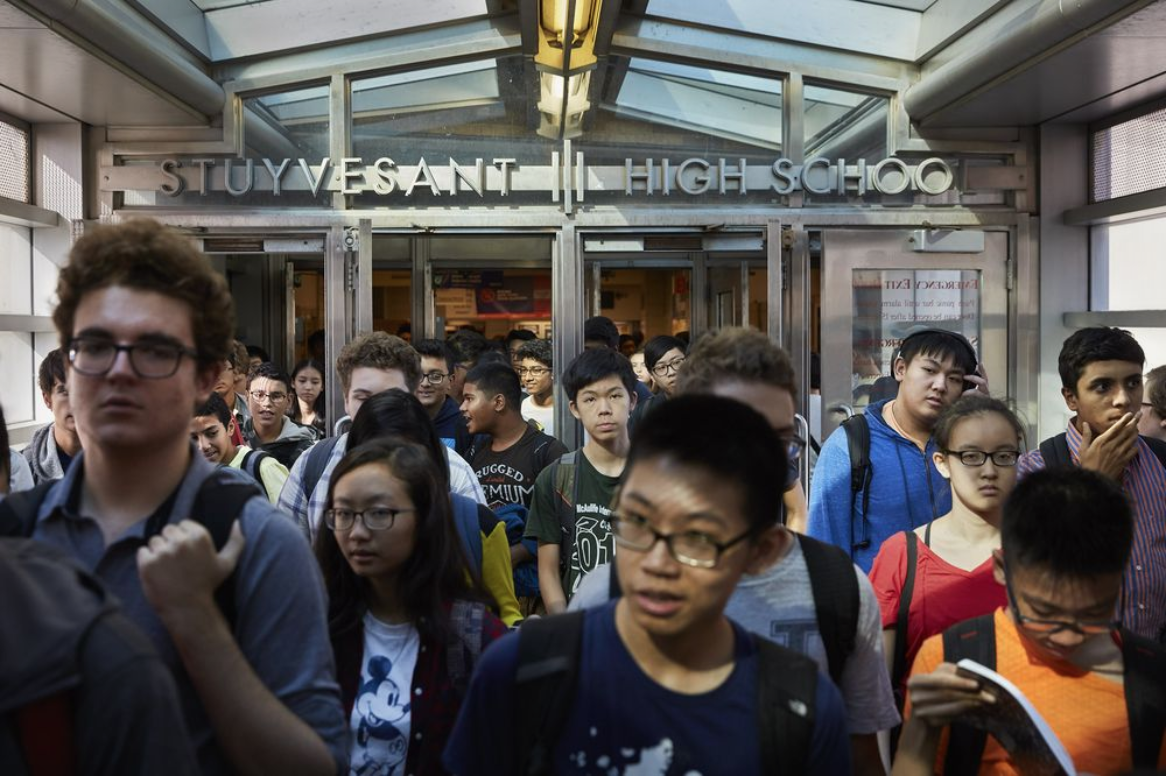A couple days ago, the NYTimes published an op-ed proclaiming “The Truth about NYC’s Elite High Schools”. The truth, according to them, is the following: NYC’s elite high schools are a bastion of bias and discrimination. In order to remedy this, they need to abandon their current test-based entrance system, in favor of one that more resembles the Ivy Leagues’ and the way they evaluate applicants “holistically”.
Let’s explore these claims for a second. Are NYC’s elite high schools truly so dysfunctional and unfair as to warrant overhauling? It’s hard to believe such a claim when you consider the following:
Three quarters of Stuyvesant students are first or second generation immigrants. And the bulk of this is made up of poor immigrants from non-college-educated families. In contrast, a mere 15% of students at Harvard are first generation college students. The number of foreign students at Harvard is only slightly higher at 20%, the majority of whom are from wealthy and powerful families overseas.
Half of Stuyvesant students come from families poor enough to qualify for free/subsidized school lunch, meaning that their families make ~$44,000 per year or less. In contrast, the median Harvard student boasts a family income of $170,000 per year.
Stuyvesant and Bronx Science, two of the most prestigious schools in NYC, also qualify for federal funding on account of their large number of low-income students. In contrast, a mere 16% of Harvard students are recipients of federal Pell Grants.
And despite this stunning breadth of socioeconomic diversity, Stuyvesant is also one of the most successful high schools in the country. Boasting a 100% graduation rate, average SAT scores of 2170, and 4 nobel laureates among its alumni. Whatever the school is doing, it’s working. It takes in some of the poorest and least privileged students in the city, and churns out successful graduates with bright futures. And it does all this in the most objective and meritocratic manner possible, without any form of quotas or special treatment. The children of poor immigrants are held to the exact same standards as the children of millionaires.
In contrast, the admissions process for getting into Harvard is one of the most opaque and subjective imaginable. It rewards those with impressive family connections. It rewards those with parents who also belong to this exclusive club. It rewards those with families that are rich beyond compare. It rewards those who are wealthy enough to afford an impressive array of made-for-college extracurriculars. To quote a research study on this subject:
We show that {privileged} applicants are especially highly rated on Harvard’s non-academic ratings. Ratings related to extracurricular activities, athletics, and personal qualities are included in the admissions process to allow for a more comprehensive view of an applicant. It is widely believed that this “holistic” approach—pursued by many competitive universities—opens doors for less advantaged applicants…
However, within racial groups, these holistic admissions criteria favor advantaged applicants. As a result, {privileged} applicants within racial groups are doubly advantaged in the admissions process. They benefit from the particular criteria Harvard uses to evaluate applicants, and they receive an additional tip in admissions decisions conditional on those criteria. These findings are consistent with Lee and Ries (2019), who find that use of non-academic admissions criteria favors white and wealthy applicants at the University of British Columbia
And the results speak for themselves. Stuyvesant is home to some of the most vulnerable, and disadvantaged students of our society. Harvard, on the other hand, is home to the preppiest and most privileged kids in the world. Stuyvesant is an engine of social mobility, whereas Harvard is a vehicle for the transfer of power and privilege from one generation to the next.
And yet, we’re being told that the Stuyvesant admissions model needs to be scrapped and overhauled, into something that looks more like what Harvard has. That we need to remove a system that is purely objective and meritocratic, and replace it with a system that is prone to all forms of subjective biases. That a system that consistently gives poor first generation college students their first shot at upward mobility, needs to give way to a system that demonstrably rewards the rich and powerful.
The critics might have a few valid suggestions. NYC’s elite high schools should use tests based on middle school curriculum that all public schools follow. They should do more to make these tests, and their prep, accessible to everyone. This would better give everyone a fair and equal shot at admission.
But looking at the big picture, it’s clear that the admissions system used by NYC’s elite schools has proven itself far more successful than anything put into practice by the nation’s elite universities. It’s time we pressured Harvard to take a page out of Stuyvesant’s book.
Related Links:
Bribery and Meritocracy in America’s Elite Universities

a first generation college student is not an immigrant, it is the first person from a family to attend college.
Hi Philip. Yes, I’m aware of that. Which part of the article do you think is incorrect?
if you look at your third paragraph, you’re contrasting number of immigrants at one school with number of first gen college students at another school. it doesn’t make much of a point, its like comparing apples to oranges
I can understand your confusion since the link isn’t explicitly spelled out. The first part of the paragraph shows that an extremely large proportion of Stuyvesant students come from poor immigrant families. The vast majority of poor immigrants aren’t college educated. Hence the conclusion that a very large proportion of Stuyvesant students will become first-generation college students.